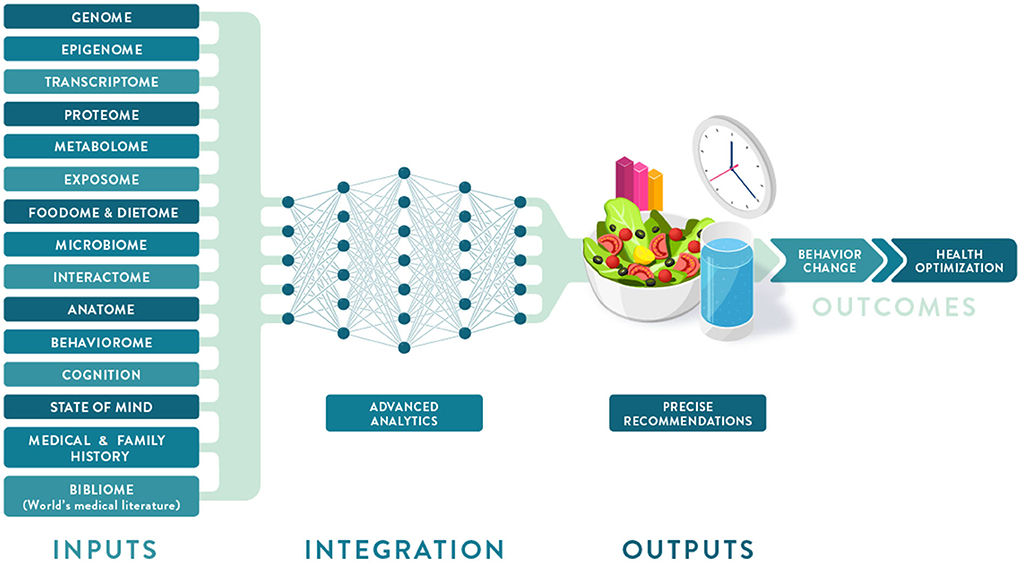Difference between revisions of "Template:Article of the week"
Shawndouglas (talk | contribs) (Updated article of the week text) |
Shawndouglas (talk | contribs) (Updated article of the week text.) |
||
| Line 1: | Line 1: | ||
<div style="float: left; margin: 0.5em 0.9em 0.4em 0em;">[[File: | <div style="float: left; margin: 0.5em 0.9em 0.4em 0em;">[[File:Fig2 Berciano FrontNutr2022 9.jpg|240px]]</div> | ||
'''"[[Journal: | '''"[[Journal:Precision nutrition: Maintaining scientific integrity while realizing market potential|Precision nutrition: Maintaining scientific integrity while realizing market potential]]"''' | ||
Precision nutrition (PN) is an approach to developing comprehensive and dynamic [[Nutritional science|nutritional]] recommendations based on individual variables, including [[genetics]], [[microbiome]], [[Basic metabolic panel|metabolic profile]], health status, physical activity, dietary pattern, and food environment, as well as socioeconomic and psychosocial characteristics. PN can help answer the question “what should I eat to be healthy?”, recognizing that what is healthful for one individual may not be the same for another, and understanding that health and responses to diet change over time. The growth of the PN market has been driven by increasing consumer interest in individualized products and services coupled with advances in technology, analytics, and [[Omics|omic sciences]]. However, important concerns are evident regarding the adequacy of scientific substantiation supporting claims for current products and services. An additional limitation to accessing PN is the current cost of [[Medical test|diagnostic tests]] and wearable [[Medical device|devices]] ... ('''[[Journal:Precision nutrition: Maintaining scientific integrity while realizing market potential|Full article...]]''')<br /> | |||
''Recently featured'': | ''Recently featured'': | ||
{{flowlist | | {{flowlist | | ||
* [[Journal:Construction of control charts to help in the stability and reliability of results in an accredited water quality control laboratory|Construction of control charts to help in the stability and reliability of results in an accredited water quality control laboratory]] | |||
* [[Journal:Application of informatics in cancer research and clinical practice: Opportunities and challenges|Application of informatics in cancer research and clinical practice: Opportunities and challenges]] | * [[Journal:Application of informatics in cancer research and clinical practice: Opportunities and challenges|Application of informatics in cancer research and clinical practice: Opportunities and challenges]] | ||
* [[Journal:Recommendations for achieving interoperable and shareable medical data in the USA|Recommendations for achieving interoperable and shareable medical data in the USA]] | * [[Journal:Recommendations for achieving interoperable and shareable medical data in the USA|Recommendations for achieving interoperable and shareable medical data in the USA]] | ||
}} | }} | ||
Revision as of 18:38, 22 May 2023
"Precision nutrition: Maintaining scientific integrity while realizing market potential"
Precision nutrition (PN) is an approach to developing comprehensive and dynamic nutritional recommendations based on individual variables, including genetics, microbiome, metabolic profile, health status, physical activity, dietary pattern, and food environment, as well as socioeconomic and psychosocial characteristics. PN can help answer the question “what should I eat to be healthy?”, recognizing that what is healthful for one individual may not be the same for another, and understanding that health and responses to diet change over time. The growth of the PN market has been driven by increasing consumer interest in individualized products and services coupled with advances in technology, analytics, and omic sciences. However, important concerns are evident regarding the adequacy of scientific substantiation supporting claims for current products and services. An additional limitation to accessing PN is the current cost of diagnostic tests and wearable devices ... (Full article...)
Recently featured:
- Construction of control charts to help in the stability and reliability of results in an accredited water quality control laboratory
- Application of informatics in cancer research and clinical practice: Opportunities and challenges
- Recommendations for achieving interoperable and shareable medical data in the USA










